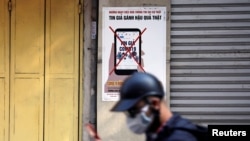In Vietnam, those who enter a cafe have a good chance of meeting a security guard who sprays their hands with disinfectant. Or, if getting on a bus, they will be told to put on a mask and sit one row apart from others.
Half a year into the COVID-19 pandemic, Vietnamese still practice health measures here and there, though the nation reported no deaths from the disease and, for more than two months, no local infections.
The statistics put Vietnam in a unique spot as the biggest nation by population to report no deaths, despite its border with China and limited resources. The statistics have ignited a debate, pitting those skeptical that a one-party state could have such success without fixing the data against those who resent the criticism.
There are autocracies like China and Iran, suspected of covering up COVID-19 deaths, and open societies like New Zealand and South Korea, whose success has gone unquestioned. Vietnam finds itself somewhere in between.
It is hard for outsiders to verify official data, though health experts say Vietnam headed off a full-blown calamity because of its drastic and early action. The government was hyper-aware of the threat to hospital and quarantine capacity.
In a meeting March 24, Ho Chi Minh City leaders said the nation could handle 1,000 cases of the coronavirus. Beyond that, they feared the health system could be inundated, as in Italy and Spain.
“During the next 10 days to two weeks, do not allow the number of cases to exceed 1,000 nationwide, otherwise the risk of disease outbreaks is very high,” a summary of the meeting on the city government website said.
Vietnam reported 349 coronavirus cases so far in 2020.
Timing was nearly as important as substance. The U.S. and Vietnam both reported their first cases in the same week in January. The U.S. could have avoided 36,000 COVID-19-related deaths if it had begun a lockdown March 8 instead of March 15, according to Columbia University. By contrast, Vietnam saw the disease as a threat early on, treating its first patient in January and proceeding to contact trace and restrict movement.
Timing was critical because of the virus’ ability to spread exponentially. The Ho Chi Minh City government said, for instance, that for every 300 people infected, 84,000 people had to quarantine. It is likely that Vietnam did not have to cover up mass infections and deaths because it acted before the virus could reach that point.
“If it was hit with the thousands, ten thousands, hundreds of thousands of cases that are being seen in other countries, it also would be overwhelmed like other countries,” Todd Pollack, head of the Harvard Medical School Partnership for Health Advancement in Vietnam, said on U.S. television network PBS. “But, at the current state, that's not the situation here.”
In addition to national coordination, targeted testing and isolation, Vietnam can decree measures regardless of public debate, like tapping a national security network to monitor the physical and virtual space. The government Vietnam News agency reported on the March 24 meetings of the Ho Chi Minh City People’s Committee.
“Standing vice chairman of the People’s Committee, Le Thanh Liem, urged local authorities and other relevant agencies to visit every house to find out if anyone has come from other countries since March 8 and test and quarantine anyone at risk at home or quarantine areas,” the report said.
Double-edged sword
In April, U.S. President Donald Trump pondered if injecting disinfectant could cure the coronavirus. Had a Vietnamese suggested such a remedy with no scientific basis on Facebook, it would not have lasted long with the government censors. This presents the double-edged sword of local controls on media.
On one hand, Vietnam used fines and takedown orders to curb the spread of false information about the virus, as have other nations. On the other hand, the controls continue a history of censorship of information that the Southeast Asian government considers unfavorable.
Social media allowed some false information to spread in Vietnam, but also greatly heightened people’s awareness of the virus and what they should do, concluded a study by 11 authors published in April in Sustainability, a science journal.
Vietnam’s success, they said, came from “mobilizing citizens’ awareness of disease prevention without spreading panic, via fostering genuine cooperation between government, civil society and private individuals.”









